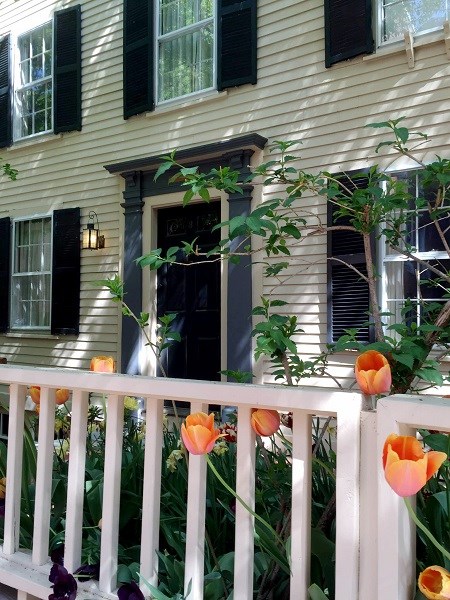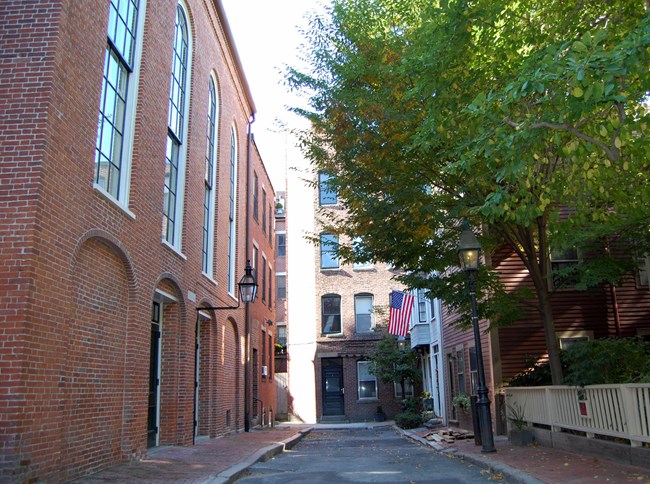|
As home to the African Meeting House and the Abiel Smith School, Smith Court served as a vital center of Black life and culture for much of 1800s and early 1900s Boston. The residences along Smith Court also provide a valuable window into the lives of those who called this neighborhood home. Today, the historic homes on Smith Court, along with the African Meeting House and the Abiel Smith School, are the best preserved physical locales available for understanding the history of African Americans in 1800s Boston. 
NPS Photo 3 Smith Court3 Smith Court, likely built in 1799, has a long association with African American occupants as well as significant activists in Boston. Starting in 1830, African Americans began renting here. George Washington, a bootblack and waiter, rented one side of the house from 1830 until 1845, while Andrew Telford and his wife Rachel Turner rented the other side. James Scott, the longest resident of 3 Smith Court, lived at this home for nearly 50 years. He rented from 1839 to 1865 then purchased the property and lived here until his death in 1888. Born in Virginia, Scott worked as a clothing dealer in Boston. In 1851, local authorities arrested, though later acquitted, Scott for his alleged role in the rescue of freedom seeker Shadrach Minkins from the Boston courthouse. Though his involvement in the Minkins rescue is unclear, Scott assisted other freedom seekers at his home. For example, on July 18, 1856, he boarded Henry Jackson and his family as they made their way to freedom on the Underground Railroad. From 1850 to 1857, William Cooper Nell also resided at 3 Smith Court. One of the most prominent community activists, Nell provided crucial leadership in the abolition movement, the Underground Railroad, and the struggle for equal rights and education. With the publication of his book Colored Patriots of the American Revolution, Nell became one of the first published African American historians. Like Scott, he also sheltered freedom seekers at his home on Smith Court.1 5 Smith Court5 Smith Court, built in the early 1800s, passed through the hands of several owners, both Black and White, prior to 1849. Peter Wilcox, his wife Chloe, and their five children lived here between 1813 and 1815. The Wilcox family joined with others that migrated with mariner Paul Cuffe to Sierra Leone. In 1849, George Washington, who previously resided at 3 Smith Court, purchased the home. Born in Massachusetts in 1795, Washington worked as a bootblack and waiter. He also served as a deacon at the First Independent Baptist Church at the African Meeting House. Washington and his wife Rachel had ten children between 1832 and 1848. They also took in boarders, including an Irish-born laborer named Patrick Barnes. Although George Washington died in 1871, this house remained in his family until 1917.2 7 Smith Court7 Smith Court, constructed in the early 1800s, had a series of owners, including African American mariner Peter Guss and later the White merchant Elihu Bates, who began renting to Black tenants in 1822. In 1857, Bates’ children sold the property to Joseph E. Scarlett, an African American chimneysweep and later a clothing dealer. Though he never lived here, Scarlett owned this building from 1857 until his death in 1898. He lived across the street at 2 Smith Court and mostly rented 7 Smith Court to other African Americans. Tenants of this property included laborer Phillip Johnson and mariners Warner Hicks and Robert Osborn. Few residents stayed longer than three years at this property.3 
NPS Photo 7A Smith Court7A Smith Court, built in 1799, is the only surviving example of the early homes that lined the eight-foot wide Holmes Alley. Throughout the 1800s, many African Americans lived in the residences along Holmes Alley, including at 7A Smith Court. Though earlier held by a succession of White owners, 7A became another rental property for Joseph Scarlett in 1858. Both Scarlett and the other landlords rented the property out to a variety of individuals and families, though most seem to have been short-term occupants.4 2 (or 10) Smith Court2 Smith Court (or 10 Smith Court), constructed in 1853, served as a home and investment property for Joseph Scarlett. Prior to construction of the Scarlett home, an earlier house stood on this site owned by William Henry, an African American tailor. Henry, his family, as well as some tenants lived here. Joseph Scarlett purchased the property in 1852 from the Henry family and soon constructed this new building. He lived here from 1860 until 1868 and eventually sold the building in 1878. By the time of his death in 1898, Scarlett owned 15 different properties in Boston, Cambridge, and Charlestown. In his will, Scarlett left bequests to the African Methodist Episcopal (A.M.E.) Zion Church and to the Home for Aged Colored Women on Myrtle Street.5 Learn More...Smith Court Stories: a collaborative project of the Museum of African American History and Boston African American National Historic Site - a unit of the National Parks of Boston. Footnotes
Additional Works ConsultedGrover, Kathryn. Make a Way Somehow: African Americans in a Northern Community. Syracuse, NY: Syracuse University Press, 1994. Horton, James Oliver. “Generations of Protest: Black Families and Social Reform in Antebellum Boson.”New England Quarterly 49, 2 (June 1976). Horton, James Oliver and Horton, Lois E. Black Bostonians; Family Life and Community Struggle in the Antebellum North, Revised Edition. New York: Holmes & Meier, 1999. Jacobs, Donald M. ed. Courage and Conscience: Black and White Abolitionists in Boston. Bloomington: Indian University Press for the Boston Athenauem, 1993. Kaplan, Sidney and Kaplan, Emma Nogrady. The Black Presence in the Era of the American Revolution. Rev. ed. Amherst: University of Massachusetts Press, 1989. Rosebrock, Ellen Fletcher. “A Historical Account of the Joy Street Block between Myrtle and Cambridge Streets.” Manuscript Prepared for the Museum if Afro- American History, Boston, 22 December 1978. Wesley, Dorothy Porter, and Constance Porter Uzelac, eds. William Cooper Nell, Nineteenth-Century African American Abolitionist Historian, Integrationits: Selected Writings, 1832-1874. Baltimore: Black Classic Press, 2002. |
Last updated: December 13, 2024
